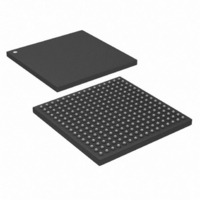DS33X161+ Maxim Integrated Products, DS33X161+ Datasheet - Page 79

DS33X161+
Manufacturer Part Number
DS33X161+
Description
IC MAPPING ETHERNET 256CSBGA
Manufacturer
Maxim Integrated Products
Datasheet
1.DS33X11.pdf
(375 pages)
Specifications of DS33X161+
Applications
Data Transport
Interface
Parallel/Serial
Voltage - Supply
1.8V, 2.5V, 3.3V
Package / Case
256-CSBGA
Mounting Type
Surface Mount
Lead Free Status / RoHS Status
Lead free / RoHS Compliant
- Current page: 79 of 375
- Download datasheet (3Mb)
When enabled, the Automatic Bridge Filter monitors the LAN input data stream to build a Bridge Filter Table based
on Ethernet Source Addresses (SA). A SA learning function allows the device build a table of source addresses
and their associated interface. If the SA of a received frame is not found in the table, then the current SA is stored
in the Bridge Filter Table. The Bridge Filter Table is then used to determine whether to forward or drop each frame
as it is received. If the Destination Address (DA) of a received frame from the LAN is equal to the value of an SA
that is already stored in the Bridge Filter table, the frame is discarded. If no match is found, then the frame is
forwarded to the WAN Groups.
An aging function is used to determine when a SA entry has aged to the point that it is no longer useful. The user
configures an Aging Period in SU.BFC.BFAP[1-9] that defines how long an SA will be stored in the Bridge table.
8.18 Bridging and Filtering
The Automatic Learning and Filtering functions for Ethernet Bridging are only applicable in 10/100Mbps Ethernet
applications. The static DA filtering functions available in the MAC may be used for 1000Mbps applications as
described in Section 8.19.3. The high-level features of the Automatic Learning and Filtering functions are shown
below:
After that time period, the entry is removed so that the position may used by another SA value. The Aging Period
can be user configured to any value from 1 second to 300 seconds in 1 second steps (300 seconds is the default
setting).
On devices with two Ethernet Ports, one Bridge Filter Table is shared by the 2 LAN Ports. An SA address that is
learned on LAN Port 1 is treated as though it was also learned on LAN Port 2. This has the effect that each frame
DA received on LAN Port 1 is tested against all SAs learned on LAN Port 1 and LAN Port 2 (the same is true for
frame DAs received on LAN Port 2). If a DA matches a stored SA from either port, the frame will be discarded.
If the LAN Trap determines that a frame matches one of the LAN Extract Trap conditions, the frame is forwarded to
the LAN Extract Queue, regardless of whether the Bridge Filter indicates that frame is to be discarded.
8.18.1 Bridge Filter Table Reset
The Bridge Filter Table Reset function is used to clear all of the Bridge Table entries. This function is automatically
triggered at power-up and can be manually triggered by the user by setting SU.BFC.BFTR to 1. During the Bridge
Filter Table Reset operation, traffic will be processed as normal. The user has the option of disabling the LAN Ports
so that there is no traffic during the Bridge Filter Table Reset process or allowing traffic to continue flowing at the
same time as the Bridge Filter Table Reset process. If the user does not disable traffic, then the table may learn
some new entries before the complete table has been reset. The Bridge Filter Table Reset function takes
approximately 64 ms to complete.
Rev: 063008
________________________________________________ DS33X162/X161/X82/X81/X42/X41/X11/W41/W11
•
•
•
•
•
Supports up to two 10/100 Ethernet Ports
Self-learning filtering table is “shared” between the two LAN Ports (not 2 independent tables)
Supports a continuous stream of 64-byte frames on both ports
Automatically learns up to 4096 MAC Addresses
Provides automatic Address Aging
79 of 375
Related parts for DS33X161+
Image
Part Number
Description
Manufacturer
Datasheet
Request
R

Part Number:
Description:
MAX7528KCWPMaxim Integrated Products [CMOS Dual 8-Bit Buffered Multiplying DACs]
Manufacturer:
Maxim Integrated Products
Datasheet:

Part Number:
Description:
Single +5V, fully integrated, 1.25Gbps laser diode driver.
Manufacturer:
Maxim Integrated Products
Datasheet:

Part Number:
Description:
Single +5V, fully integrated, 155Mbps laser diode driver.
Manufacturer:
Maxim Integrated Products
Datasheet:

Part Number:
Description:
VRD11/VRD10, K8 Rev F 2/3/4-Phase PWM Controllers with Integrated Dual MOSFET Drivers
Manufacturer:
Maxim Integrated Products
Datasheet:

Part Number:
Description:
Highly Integrated Level 2 SMBus Battery Chargers
Manufacturer:
Maxim Integrated Products
Datasheet:

Part Number:
Description:
Current Monitor and Accumulator with Integrated Sense Resistor; ; Temperature Range: -40°C to +85°C
Manufacturer:
Maxim Integrated Products

Part Number:
Description:
TSSOP 14/A°/RS-485 Transceivers with Integrated 100O/120O Termination Resis
Manufacturer:
Maxim Integrated Products

Part Number:
Description:
TSSOP 14/A°/RS-485 Transceivers with Integrated 100O/120O Termination Resis
Manufacturer:
Maxim Integrated Products

Part Number:
Description:
QFN 16/A°/AC-DC and DC-DC Peak-Current-Mode Converters with Integrated Step
Manufacturer:
Maxim Integrated Products

Part Number:
Description:
TDFN/A/65V, 1A, 600KHZ, SYNCHRONOUS STEP-DOWN REGULATOR WITH INTEGRATED SWI
Manufacturer:
Maxim Integrated Products

Part Number:
Description:
Integrated Temperature Controller f
Manufacturer:
Maxim Integrated Products

Part Number:
Description:
SOT23-6/I°/45MHz to 650MHz, Integrated IF VCOs with Differential Output
Manufacturer:
Maxim Integrated Products

Part Number:
Description:
SOT23-6/I°/45MHz to 650MHz, Integrated IF VCOs with Differential Output
Manufacturer:
Maxim Integrated Products

Part Number:
Description:
EVALUATION KIT/2.4GHZ TO 2.5GHZ 802.11G/B RF TRANSCEIVER WITH INTEGRATED PA
Manufacturer:
Maxim Integrated Products

Part Number:
Description:
QFN/E/DUAL PCIE/SATA HIGH SPEED SWITCH WITH INTEGRATED BIAS RESISTOR
Manufacturer:
Maxim Integrated Products
Datasheet:










